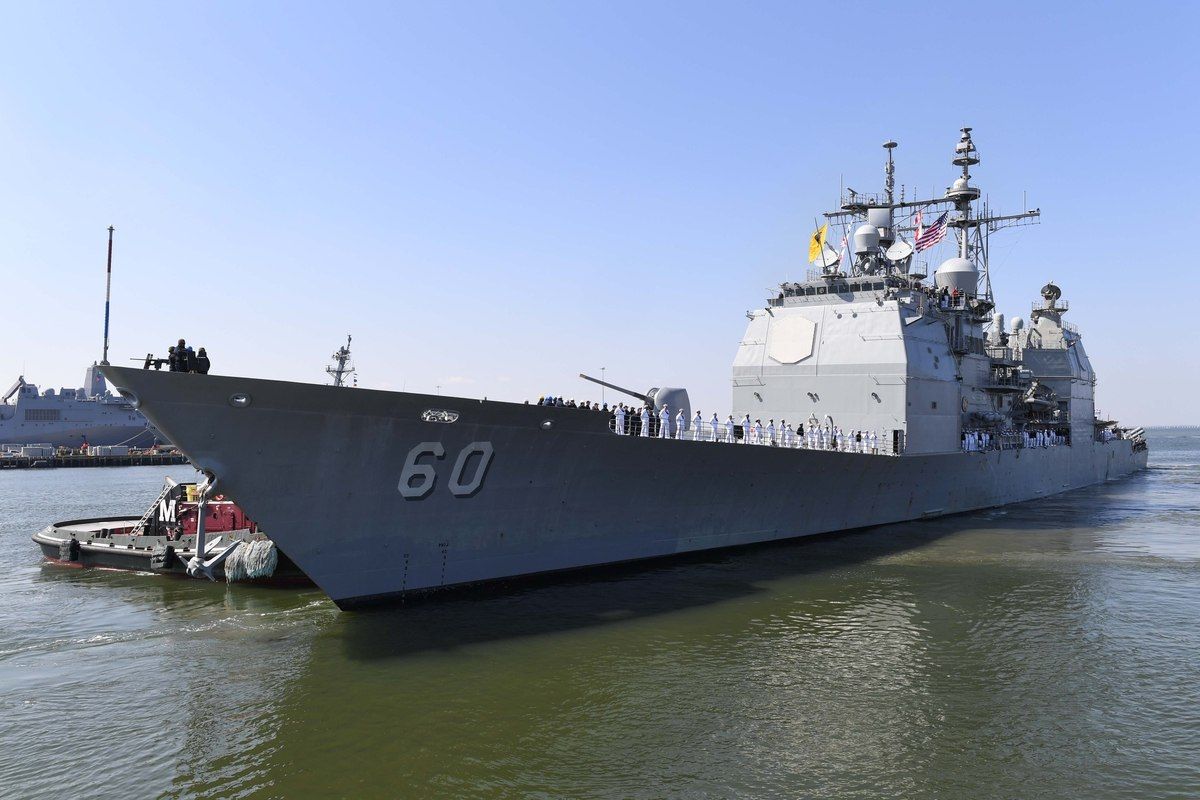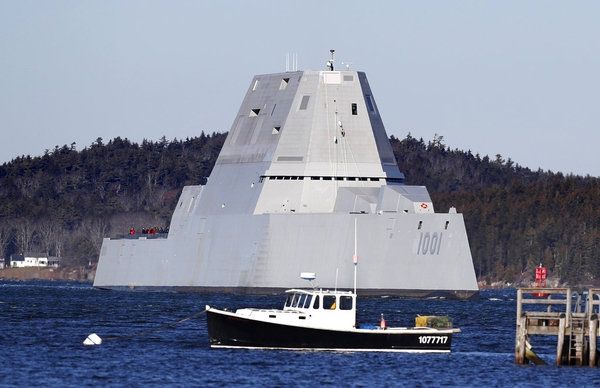Mike
Navy’s top officer lays out aggressive new cruiser replacement approach
By: David B. Larter 18 hours ago

The cruiser Normandy gets underway for deployment as part of the Harry S. Truman Carrier Strike Group. (MC3 Colbey Livingston/Navy)
WASHINGTON – Buoyed by rapid progress on the next-generation frigate, the U.S. Navy’s top officer is ready to quickly move out on the long-debated replacement for the Navy’s aging cruisers.
In an exclusive interview with Defense News, Chief of Naval Operations Adm. John Richardson laid out a strategy for a new large surface combatant that uses some of the tricks the Navy is employing on the FFG(X) program: looking at existing hull forms as a base for a tailor-made future combatant that can evolve over time.
“We’re going to start putting the pedal to the metal on the next major surface combatant,” Richardson said Wednesday afternoon. “I think we learned a lot in the frigate discussion and turned around the major surface combatant discussion in record time.
“I’d like to do the whole thing, well, as fast as possible but do it in the frigate timeframes: in terms of defining what we want, the requirements, getting industry involved, making it a very open competition."
The Navy will be zeroing in on what they want out of their new ship very quickly, Richardson said, which means shipbuilders and industry could be getting bids together on the Navy’s new major surface combatant in a matter of months instead of years.
“I’d like to get this pretty well defined in the 2018, 2019 timeframe,” he said.
Richardson pointed to three main focus areas for a new major surface combatant: An existing hull form to speed up acquisition; excess power capacity; and the ability to rapidly switch out systems.
“Some parts of that ship are going to be very similar to ships that are around right now (hull forms) and that’s going to last the life of the ship,” Richardson said. “So, let’s get a hull form — and there are probably ones out there that are just fine."
The second area Richardson pointed to is the electrical plant, a must if the Navy is going to integrate lasers and electromagnetic weapons in the future.
“Power plant and power generation — you need to really pay attention to that because its very hard to change after you buy it," he said. "And if you think about the kinds of combat systems and weapons systems we’re going to have on future ships, they have got to be able to generate pulsed power and those sorts of things.
“So, lots of power. Buy as much power as you can afford because it’s like RAM on your computer, you’re going to need more as soon as you buy it.”
The third area, Richardson said, is that new technology must be easily switched during short stints in the yards, not requiring major ship alterations to accommodate new systems.
“Everything else, though, is swappable,” Richardson continued. “And that has to be designed in to the DNA of the ship so you can come in on a short upkeep and swap out your radar system, or your combat system, or put this weapons system in.
“It has a lot to do with designing standards so that everybody can build to those standards so it’s a much more dynamic, swappable type of a thing.”
Since taking over as CNO, Richardson has championed an aggressive approach to acquisitions that brings in industry earlier in the process to define what is possible with mature or maturing systems, an approach designed to get new technology out in the fleet faster than the long timeline associated with developing new technologies for a blank-slate design.
It’s an approach he’s pushed with the FFG(X) and the unmanned MQ-25 Stingray tanker. The idea is to get new tech out in the fleet quickly and in the hands of sailors and officers to put it to work.
“We’ll get this design done. And because some things will be permanent and some things will be swappable, let’s just get that thing out there. It will be 100 percent better than the current cruiser,” Richardson said. “And then [when] we get smarter, we’ll put the next iteration out there.”
Power and sensors
Experts who reviewed Richardson's comments on the next surface combatant were generally positive about the CNO's approach to getting the next large surface ship on the water sooner rather than later.
An important part of the discussion about a new large combatant of this nature will be what sensors the Navy wants on it, said Bryan Clark, a retired submarine officer and analyst with the Center for Strategic and Budgetary Assessments.
One of the growing concerns among Navy leaders is the massive radar signature of the fixed phased-array radars that have been the fixture of the AEGIS surface Navy.
“I would be very interested in what the Navy is thinking regarding the main sensors of the future large surface combatant,” Clark said. “The vulnerability of active sensors to counter-detection may argue for the next large surface combatant having large, high-gain passive sensors.”
Clark said it was a great move to ensure that the next surface combatant has excess power and capacity for future capabilities. The Navy’s current large surface combatant program, the DDG-51 destroyers, are moving on to a Flight III variant that supports Raytheon’s AN/SPY-6 Air and Missile Defense Radar.
But to support the power-hungry sensor, engineers had to pack a ton of extra power generation capability in the Arleigh Burke hull form.
The Navy has said that the addition of more power just about maxed out space inside the Burke.
This suggests that the Burke hull form is probably not appropriate for the next major surface combatant under the parameters laid out by CNO, Clark said, and it may suggest the Navy has even broader plans for this hull than just replacing the cruisers.
“This approach will help get the new large surface combatant out there sooner, which would help the Navy address the constraints of the DDG-51 design, which with Flight III has little margin left for growth,” he said. “The desire for a faster design process suggests the Navy wants to shift to a new large surface combatant design earlier than 2029, which is when he next [large surface combatant] appears in the FY19 shipbuilding plan.
“The CNO is talking about the new surface combatant as if it were a replacement for the [cruisers], but the shipbuilding plan does not reflect two classes of large surface combatants being constructed. I assume this new ship will replace the CGs initially and then replace the DDG-51 Flight 1s.”
Hull contenders
If CNO wants to build the ship into an existing hull forms with lots of extra capacity, the list of contenders isn’t very long at the moment.
Most countries are focused on frigate-sized ships, which meant the Navy had a glut of contenders for FFG(X), but there is a much more limited supply of large surface combatants, said Jerry Hendrix, a retired Navy captain and analyst with the Center for a New American Security.
“As I see it just right off the bat, there are really only three: the British Type 26, Burke and the Zumwalt (DDG-1000),” Hendrix said. And of those contenders, really only Zumwalt has the excess power generation CNO is looking for.
Huntington Ingalls has also done designs for its LPD-17 San Antonio-class amphibious transport dock that added vertical launch tubes and other surface combatant capabilities, but such a ship would have difficulty keeping up with the aircraft carrier, Hendrix added.

The future USS Michael Monsoor passes Fort Popham travels down the Kennebec River as it heads out to sea for trials, Monday, Dec. 4, 2017, in Phippsburg, Maine. The ship is the second in the stealthy Zumwalt class of destroyers. (Robert F. BukatyAP)
Using the Zumwalt hull form has its own challenges, said Clark. The Navy has been thrilled with the extra space and extra power generation the Zumwalt offers, but stability in the water for the stealthy destroyer has been a limiting factor in some conditions, he said.
Bryan McGrath, a retired destroyer skipper and consultant with The FerryBridge Group, said the focus on power and quick upgrades was good, but agreed that that stock of large combatant hulls is slim at the moment.
“Focusing on power is a good thing,” McGrath said. “Focusing on the ability to rapidly modernize through what he calls ‘swappable’ capabilities is a good thing. I hope [CNO] has an open mind on hull forms though, as I think the DDG-51 hull form is about played out and likely wouldn’t be large enough to accommodate the basket of things we want on a large surface combatant, leaving the DDG-1000 and the LPD-17 from existing U.S. designs.”
“Both are fine ships, but I’d like to see what the naval architecture and design community is capable of before limiting the playing field.”


